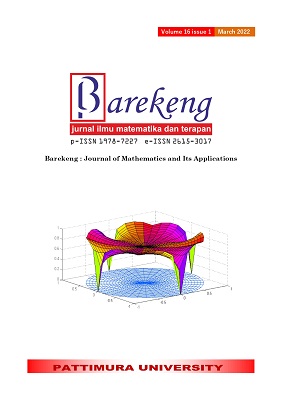COMPARATIVE STUDY: THE DIFFERENCES STUDENTS’ LEARNING BASED ON GENDER
Abstract
This research is motivated by variuous ways in students absorb, organize and process information received, such as there are students easier to remember the material given visually than auditory or vice, there are students who difficult to write, but good telling stories, there are students who easily disturbed by noise, there are students can't sit still for a long time and there are students prefer practical activities. This study is a comparative to determine differences in learning styles between male and female students at SMP Yapis Merauke. The research sample amounted to 80 students. Data was collected from a learning style questionnaire and analyzed descriptively and inferentially. Descriptive analysis shows dominant male students had auditory and dominant female students had a visual learning style. Inferential analysis with the Anova test showed a significant value of p=0,00 (p<0,05), which means a difference between the learning styles of males and females
Downloads
References
Djamarah, Syaifu Bahri. Psikologi Belajar. Jakarta:Rineka Cipta, 2018.
L. Bire, A and J. Geradus, U.,& Bire, “Pengaruh Gaya Belajar Visual, Auditori, dan Kinestetik Terhadap Prestasi Belajar Siswa,” J. KEPENDIDIKAN, vol. 44, no. 2, pp. 168–174, 2014.
D. Porter, Bobbi, and M. Hernacki, Quantum Learning: Membiasakan Belajar Nyaman dan Menyenangkan. Terjemahan Alwiyah Abdurrahman. Quantum Learning: Unleasting The Genius In You. Bandung: Kaifa, 2015.
Rachmawati, Tuti, and Daryanto, Teori Belajar dan Proses Pembelajaran yang Mendidik. Yogyakarta: Gava Media, 2015.
A. Saparuddin and M. Palobo, “Profil Kemampuan Pemecahan Masalah Matematika Siswa Ditinjau Dari perbedaan Gaya Kognitif dan Gender,” Kreano J. Mat. Kreat., vol. 2, pp. 139–148, 2018.
J. Santrock, Psikologi Pendidikan. Jakarta: Salemba Humanika, 2011.
Sumar, W.T, “Implementasi Kesetaraan Gender dalam bidang pendidikan”, vol. 7, no. 1, pp. 158–182, Juni 2017.
T. . Nugraha and H. Pujiastuti, “Analisis Kemampuan Komunikasi Matematis Siswa Berdasarkan perbedaan Gender,” EDUMATICAJurnal Pendidik. Mat., vol. 1, no. 1, 2019.
H. Fatmawati., E. M.Y., Damayanti, and M. . Rasyid, “Gaya Belajar peserta Didik Ditinjau Dari Perbedaan Jenis Kelamin,” Al Asma J. Islam. Educ., vol. 2, no. 1, 2020.
Wulandari, “Eksperimentasi Model Pembelajaran Survey, Question, Read, Recite, Review (SQ3R) dan SQ4R Ditinjau Dari Jenis Kelamin dan Gaya kognitif,” J. Elektron. Pembelajaran Mat., vol. 4, no. 1, 2016.
Nurjan, S. Psikologi Belajar Edisi Revisi. Ponorogo:Wade Group. 2016.
Fitri, J.,Jalmo, & T.,Marpaung, R.R.T. “Identifikasi Gaya Belajar Berdasarkan Gender Dengan hasil Belajar IPA,”Jurnal FKIP Unila, 2017.
Aprianto. “Studi Gaya Belajar Kinestetik,”Jurnal Kependidikan, vol. 2, no.1, pp. 75-82, 2014.
Sujarwo. “Pengaruh Metode pembelajaran dan Gaya Belajar Terhadap Hasil Belajar,”Jurnal Kependidikan, vol. 5, no.10, pp. 115-122, 2012.
Slamet. “Eksplorasi Gaya Belajar, Efikasi Diri Dan Intensitas Belajar Mahasiwa Pada Kegiatan Site Visit Survey Learning,”Jurnal Pendidikan Teknologi dan Kejuruan, vol. 22, no.1, pp. 75-82, 2014.
Wijayanti, O. I. “Perbedaan Gaya Belajar Antara Siswa Laki-Laki Dan Siswa Perempuan Dalam Belajar Matematika Pada Siswa Kelas VIII SMP Kristen Satya Wacana Salatiga. [Online], 2013.
Damayanti, N. “Perbedaan Jenis Kelamin Terhadap Minat Berwirausaha Mahasiswa Jurusan Pendidikan Ekonomi Universitas Negeri Surabaya,”Jurnal Pendidikan Tata Negara, vol. 1, no. 3, 2013.
S. Arief, M. and S. Ulfa, “Hubungan Gaya Belajar Berdasarkan Gender Dengan Hasil Belajar Pada Mahasiswa Teknologi Pendidikan Universitas Negeri Malang,” J. Pendidik. Kaji. Teknol. Pendidik., 2018.
Suryani, D.R.,& Lestari, N, “ Penggunaan Media Pembelajaran Untuk Meningkatkan Motivasi Dan Minat Belajar Matematika Siswa Kelas XI IPS 3 SMA Negeri 2 Merauke ,”MJME, 2019.
Authors who publish with this Journal agree to the following terms:
- Author retain copyright and grant the journal right of first publication with the work simultaneously licensed under a creative commons attribution license that allow others to share the work within an acknowledgement of the work’s authorship and initial publication of this journal.
- Authors are able to enter into separate, additional contractual arrangement for the non-exclusive distribution of the journal’s published version of the work (e.g. acknowledgement of its initial publication in this journal).
- Authors are permitted and encouraged to post their work online (e.g. in institutional repositories or on their websites) prior to and during the submission process, as it can lead to productive exchanges, as well as earlier and greater citation of published works.






1.gif)



